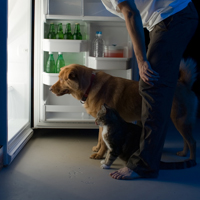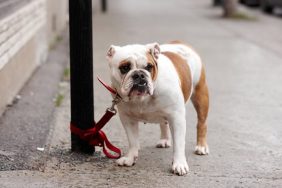Last month, DogTime.com reported that more than half of dogs here in the United States are overweight or obese. That’s over 50 percent of our canine companions who are walking around — or, as the case may be, laying around — at risk for serious conditions because of their weight.
Obesity can cause strain on a dog’s liver, kidneys, joints, lungs, and heart. Dogs with a substantial amount of extra pounds are at risk for arthritis, high blood pressure, hypertension, many cancers, and canine diabetes, all of which could not only shorten your pet’s life, but decrease your pet’s quality of life, too.
And cat owners, don’t think you’re off the hook; according to the 2012 survey conducted by the Association for Pet Obesity Prevention (APOP), a whopping 58.3 percent of cats — approximately 43.2 million tabbies, torties, calicoes and more — in this country are overweight or obese. That means nearly 3 out of 5 U.S. cats are flabby felines who are at risk for a whole host of health issues. It is because of the health risks obesity poses to American pets that APOP created the National Pet Obesity Awareness Day seven years ago. This annual event is a time to collect important data about the health of U.S. dogs and cats, but also for pet owners to take a good, honest look at their pet’s weight and health. This year’s National Pet Obesity Awareness Day is today, October 9, and veterinarians on both coasts and everywhere in between are being asked to participate in APOP’s 2013 National Pet Obesity Survey. Today, veterinary offices participating in the survey will keep a special record of each canine and feline patient’s basic body composition. The data will be compiled at APOP’s headquarters before the results of the 2013 survey are released to the public. “Our historical research shows a clear epidemic of pet obesity in our country,” explains APOP’s founder and president, veterinarian Dr. Ernie Ward. “The annual veterinarian-conducted study is vital to measuring the longitudinal trend so our industry is informed.” “Armed with this knowledge, APOP, the veterinary community and entire pet industry can set forth common strategies to fight and prevent overweight pets, because we all want to give them longer, healthier and happier lives,” Dr. Ward tells Veterinary Practice News. If you didn’t sign up to participate in the APOP study this year, don’t worry — you can still participate in National Pet Obesity Awareness Day by conducting your own dog or cat obesity examination at home. Run your hands over your pet’s abdominal area, spine, and ribs to check for excess fat. If you can easily feel your pet’s ribs, if your pet’s stomach doesn’t sag, and if your pet seems to have an obvious waist when viewed from above, then that indicates Fido or Fluffy is likely a healthy weight. In overweight or obese pets, layers of fat make it difficult for pet owners to feel the ribs underneath. The pet’s stomach hangs, creating a sagging pooch of fat, and, when viewed from above, the owner can’t see a well-defined waist. If you suspect Fido or Fluffy has weight issues, take the initiative and make an appointment with your trusted veterinarian. Together, you and the doctor can create a weight loss plan that is safe and effective for your pet. For more information about National Pet Obesity Awareness Day 2013, the complete results of last year’s survey, or for a variety of different tools you can use to help fight obesity in dogs and cats, check out the Association for Pet Obesity Prevention website at www.petobesityprevention.com. Sources: Association for Pet Obesity Prevention, Veterinary Practice News









